
 |
|||||
|
|
|||||
|
|
|
|||||
|
|
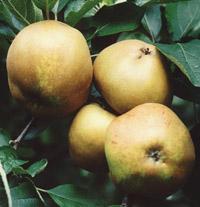 |
WHEELER’S RUSSET Long thought to have been raised by James Wheeler, but Hogg stated that he had found it in a catalogue of the Brompton Park Nursey in 1717, when Wheeler would have been only a child. Medium sized fruit, the yellow skin almost completely covered with golden russet, sometimes blushed red. The flesh is greenish-white, fairly hard and sharp initially, but in late November it is less hard, crisp, juicier and richly flavoured. Trees have pretty blossom, and good crops. Ripe late November and storing until March. T* Pollination Group 4 |
||
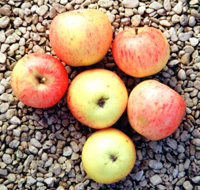 |
WHEELWRIGHT We saw this tree at Orchard Cottage in old Little Ickford, in Buckinghamshire, but close to the Oxfordshire border, many years ago and took some scion wood to grow a tree here. On a recent return we found the former owner and the tree had gone. The cottage is now owned by Bill and Lesley Haxworth, and we have returned a new tree to them. Bill and Lesley would like to call this apple “Wheelwright”, after the four generations of wheelwrights who lived there before the mid 1980s. A medium sized yellow apple with pretty red streaks that in most years will bear heavy crops. Apples are ripe in early October and are crunchy, crisp, juicy, and sweet with a good underlying flavour. With care the apples remain good into December. Pollination Group 4 |
|||
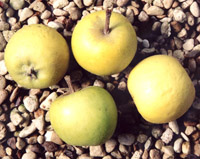 |
WHITE
JOANETING It has been wrongly merged in with Joaneting and many
synonyms of both have added to the confusion. There were several different
coloured versions of Joaneting, or Juneating, recorded in the 19th century,
though the name is much older. Only two, Joaneting (Red Joaneting) and
White Joaneting are currently known, though the others probably still
exist, incognito. A dessert apple mentioned about 1600 by Bacon, and long
appreciated because it was one of the first apples to ripen, though it
must be eaten soon after picking, not keeping long. Small, sweet apples,
crisp and with a fresh flavour. Good crops. Pollination Group 1 |
|||
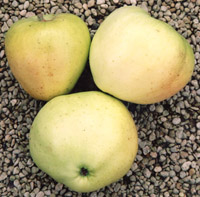 |
WHITE
MELROSE An old Scottish apple, first recorded in 1826, but probably
older, and appearing to originate with the monks of Melrose Abbey. Once
grown almost exclusively in the border counties, it is very hardy. Large,
tall, conical apples, with smooth pale skin and red markings, turning
yellow when ripe. A cooker that keeps some shape when cooked and has a
good sweet flavour with modest acid. It is also a refreshing and mild,
crisp, sweet, juicy eater, when fully ripe. Vigorous trees with heavy
crops. Stores until November. Pollination Group 3 |
|||
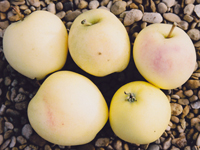 |
WHITE SPANISH REINETTE A truly historic apple (also known as Reinette Blanche D’Espagne) which seems to have disappeared in Britain, as far as named examples are concerned, by the end of the 19th century. Dating back to the early 1600s, in Europe, it was first noted in Britain in the first catalogue of the London Horticultural Society in 1826. In Britain, though widely acclaimed throughout the 19th century, there are no 20th century sightings of it and though it will doubtless still be growing somewhere, its name forgotten, it could not be found by us. It did not appear to be held in foreign collections. Our last resort was to seek it under its ancient Spanish name of Camuesar. Success eluded us until Christine Nichols, ecologist and local historian of Wolverton, Milton Keynes, put us in touch with a fruit tree grower in New Zealand, whom she knew to have some old European apples. Having contacted him we found that he had Camuesas di Llobregat in his collection. Dieter Proebst had shifted his work to orcharding and fruit processing but still had a tree and sent scionwood in 2008. He reports that his tree came from Bob Crowder’s collection at Lincoln College, Christchurch. Our trees have now fruited and we are certain it is White Spanish Reinette. We greatly appreciate the help of Christine and Dieter. Apples are oblong to conical with glossy skin of pale green, becoming pale lemon, dotted with pale lenticels and with a warm flush in the sun. The stalk is short, obliquely set and often with a fleshy edge, set in a shallow and narrow cavity, with a small amount of smooth brown rayed russet. The eye is small and closed or half open, in a narrow ribbed basin, with erect or recurved sepals. The core is very open to the point of having ‘open plan’ cells. The flesh is pale cream, crisp, fine and very juicy with an excellent sweet and lemony flavour. It is a very refreshing dessert apple. It can also be eaten when under-ripe by those less concerned with full sweetness and liking a bit of sharpness. Historic descriptions of it have also accounted it a very good cooking apple. When cooked, we found that it kept its shape completely, to the point of putting up some resistance, though the flavour was rich and well rounded. It would be an excellent apple for baked tarts. Trees are free spurring, fruit when young and reliably. Pollination Group 4 |
|||
|
||||
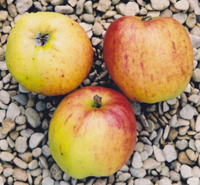 |
WHITEBECK
PEARMAIN A very old tree found at Whitebeck Orchard, Lyth Valley,
Westmorland by Hilary Wilson of Appleby-in-Westmorland. The orchard, owned
by Desmond Holmes, was once commercially productive. The Holmes family
settled at Whitebeck in 1747 and sold fruit to market until the 1960s.
This anonymous tree, with unusual frilly leaves, produces quite large,
oval eating apples, boldly streaked. Ripe towards the end of October in
the South, the flesh is yellowish, crisp, tender and juicy with a sweet
and rich flavour, low in acid. The fruit will last to the year end. Pollination
Group 3 |
|||
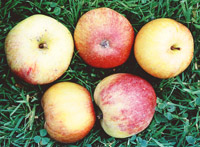 |
WILLIAM
CRUMP Bred in 1908, from a cross between Cox’s Orange Pippin
and Worcester Pearmain. One history says it was raised by Mr Carless,
the foreman at Rowe’s Nurseries, Worcester, where it was introduced,
but Taylor and Bunyard say it was raised by William Crump, head gardener
at Madresfield Court and introduced by Rowe’s. It has since become
very popular in private gardens. A medium to large (sometimes very large)
dessert apple, flattened conical in shape. The green-yellow skin is almost
wholly covered in dark red in the sun, with pale russet on the shaded
side. The flesh is cream with traces of green, crisp, sweet and juicy.
Ripe in November, better in December and keeping into the New Year. The
trees have an upright growth. Pollination Group 4 |
|||
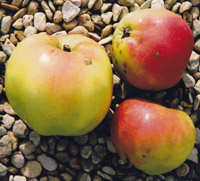 |
WILLIAM
RANDALL A first class dual purpose apple in the orchard of the
late Maurice Randall, local cherry expert at Prestwood, Buckinghamshire,
and the donor to us of the cherries, Prestwood Black and Black Eagle.
We were led to Maurice by George Lewis of Prestwood Nature. This particular
tree was planted by Maurice’s father, William Randall, around 1900,
though it is unknown whether it was a named variety or grown from a pip,
by William. The medium to large, flat apples are pale green with a warm
cerise blush and a few pale red streaks. They can sometimes have a striking
maroon flush. Although the irregularly shaped apples can be quite large
for eating, they are crisp, juicy, very sweet and fragrant, with a pleasing
savoury aftertaste. When cooked, the flesh softens quickly but keeps its
shape completely, the pale colour turning to a warm deep cream. The texture
is slightly granular, like a cooked pear, and would make an excellent
apple for tarts or for baking. The flavour is full and sweet, not particularly
acid, but with enough tang to complete the flavour. An excellent dessert
and cooking apple. When cut, the flesh does not discolour, even for several
hours, at least. The apple also has large showy flowers. Pollination Group
4 |
|||
|
||||